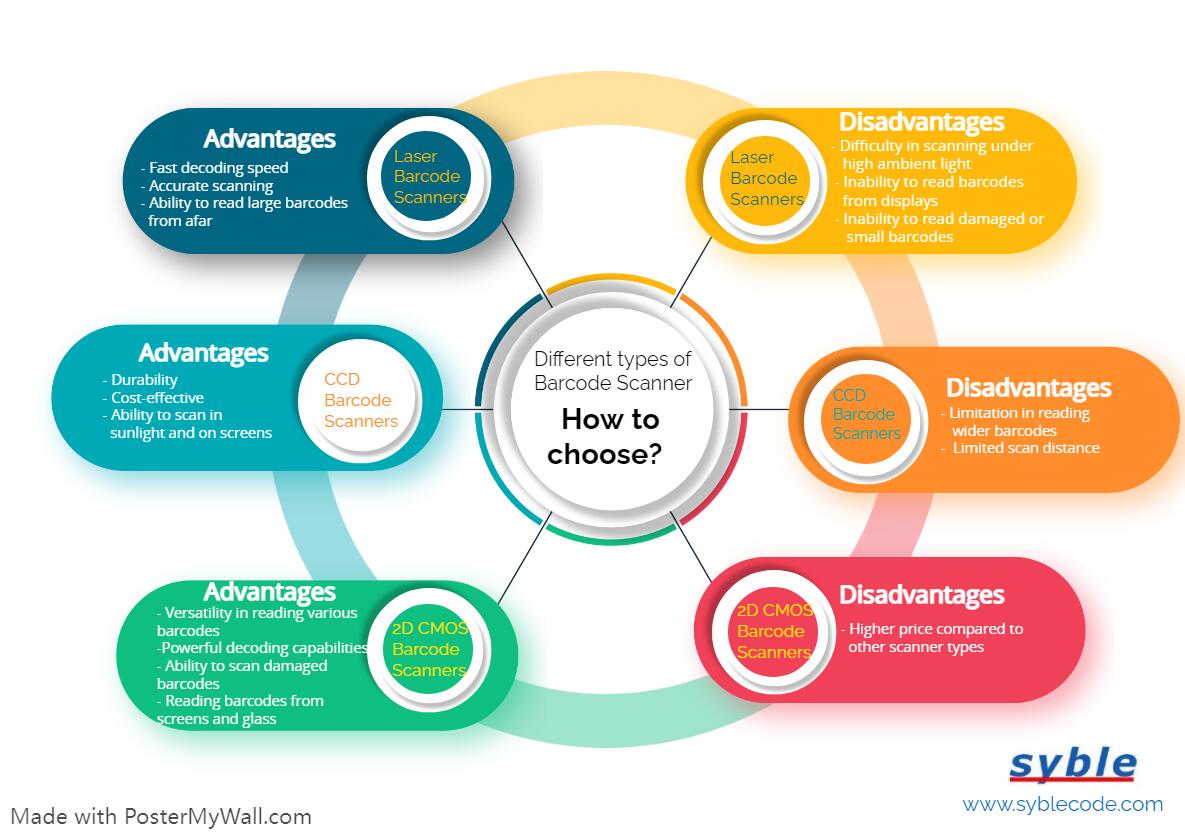how can we help you

There are 3 popular types of barcode scanners: Laser Barcode Scanner, CCD barcode scanners, and 2D CMOS Barcode Scanners. We have outlined the advantages and disadvantages of all 3 types and what will help you to understand and choose the suitable one for you.
1. Laser Barcode Scanners
The laser barcode scanner is the most common and the most popular. The laser scanner operates by emitting a red diode laser that reflects back the barcode for processing. Bluetooth laser barcode scanners are small and easy to use. Due to their portability, they are the perfect solution for inventory, attendance, or retail arbitrage.
Advantages:
♦ Fast: Laser scanners can decode extremely fast. For example, the syble laser barcode scsnner Scanner can decode 150 scans per second.
♦ Accurate: Laser scanners scan most 1D barcodes with ease. Just point and scan for quick results.
♦ Powerful: Unlike a CCD scanner, laser scanners can read large barcodes and from longer distances. Some laser scanners can read barcodes from over 50 feet away.
Disadvantages:
♦ Ambient Light: Because a laser scanner functions by reflecting light back, high ambient light (such as direct sunlight) may cause difficulties when trying to scan.
♦ Laser Limitations: Most laser barcode scanners cannot read barcodes from a computer or mobile device display. Furthermore, if the barcode is damaged, faded or too small in scale, the laser barcode scanner may not be able to capture the scan.
2. CCD Barcode Scanners (Linear Imagers)
CCD (Charged Coupling Device) barcode scanners use an imaging engine to take a picture of the barcode and then decode the characters. CCD barcode scanners are "linear imagers" meaning that you will still see a red focus line when triggering the scan.
Advantages:
♦ Durable: CCD scanners have no internal moving parts so they are typically a bit more durable than a laser scanner.
♦ More economical: CCD scanners, on average, are usually less costly than other barcode scanners.
♦ Scan In Direct Sunlight & On Device Screens: Essentially, a CCD scanner is "taking a picture" of the barcode. Due to this scanning process, CCD scanners are able to operate in bright sunlight. Most CCD scanners are also able to read scans off a computer or other devices screens.
Disadvantages:
♦ Barcode Size Limitations: CCD scanners are unable to read barcodes that are wider than the imager line.
♦ Scan Distance Limitations: Most CCD scanners are only able to read barcodes from a few inches away.
3. 2D CMOS Barcode Scanners
2D CMOS Barcode Scanners capture an image field and then decode the result. Due to 2D imagers having a wider scope or area than other barcode scanners, a 2D imager can read virtually any 1D or 2D barcode including: QR codes, Data Matrix, and PDF417. 2D imagers are the most powerful of the 3 barcode scanners and are ideal for individuals needing rapid scanning action, such as those at an event or working in outdoor environments.
Advantages:
♦ Versatility: A 2D barcode scanner can scan virtually every barcode symbology.
♦ Powerful: 2D scanners, because of their image capture processing, can read barcodes from nearly every surface type including computer or mobile device screens, and even scan through glass surfaces. Their decoding ability also allows for the user to successfully read heavily damaged barcodes.
Disadvantages:
♦ Price: 2D barcode scanners are typically more expensive than linear imagers or laser barcode scanners.